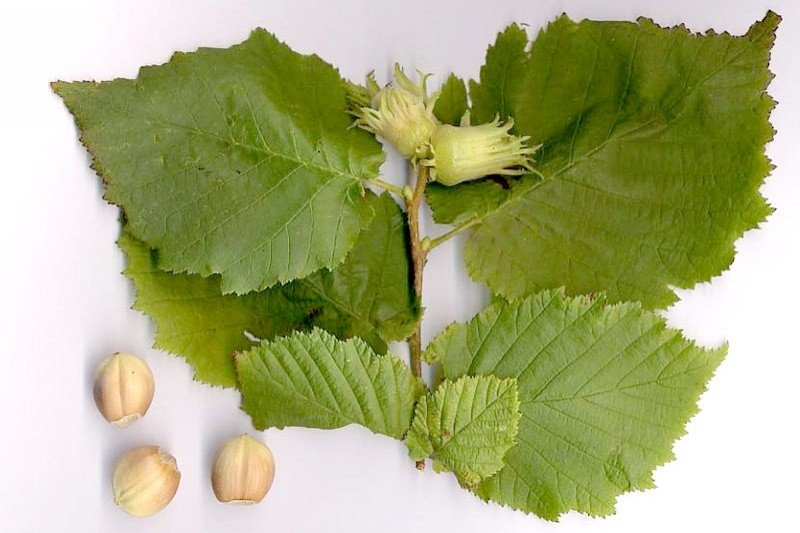
Characteristics and Interesting Facts
- The hazel (Corylus) is a genus of deciduous trees and large shrubs native to the temperate Northern Hemisphere with 14–18 species . The genus is usually placed in the birch family Betulaceae, though some botanists split the hazels (with the hornbeams and allied genera) into a separate family Corylaceae.
- Hazel requires a winter chilling period of 800 – 1200 hrs below 7 C (45 F) which is similar to apples .
- One of the smallest native tree species in the UK and has been been growing in the isles for at least 11,000 years, with evidence of consumption of hazelnuts by stone age men.
- Hazel is often coppiced but if left to grow, it can reach a height of 8 to 12m when mature. (Coppicing is an ancient form of woodland management, that involves repetitive felling on the same stump, near to ground level, and allowing the shoots to regrow from that main stump.)
- With the decline in coppicing in many woods, hazel is being shaded out by invading sycamore, oaks and ash. It can only produce pollen in strong light and so is beginning to be replaced in woods.
- Hazel is able to bear fruit for 50 years and lives upward of 80 years. It can live several hundred years if coppiced.
- 748,000 metric tons of hazelnuts are produced each year. Nearly 75% of globally consumed hazelnuts originate from Turkey.
- At the sites of many sacred wells in Britain the presence of hazel is found, either in archeological remains or actually growing. Hazel has long been associated with water as it grows best on boggy wet ground, and hazel rods were the preferred wood for water divining.
- For my friends in Scotland: In Scots Gaelic the word for Hazel is variously Calltuin or Calltainn. In Irish it is Coll. Derivations of this word can be seen in place names such as the famous Calton Hill in Edinburgh, suggesting that Calton Hill may once have been populated by a grove of hazel trees.

Coppiced hazel regenerates shoots as pictured above and allow for harvests every 5 to 7 years.
Uses

- Each tree produces 3 to 5 kilograms of hazelnuts per year and harvest takes place from September to October. Mature nuts fall to the ground which can be collected manually or with a help of specially designed machine that works like a vacuum cleaner.
- Hazelnut is edible raw or roasted, or ground into a paste.
- Oil extracted from the hazelnuts is used as vegetable oil for cooking. This oil also has application in cosmetic and pharmaceutical industry and in aromatherapy.
- Hazel was woven into hurdles for fencing, made into fish traps, used for thatching poles and is still used to stake hedges after laying. Much was burnt to make charcoal.
- Hazel nuts contain double the protein and good fats of the same amount of eggs and are good sources of vitamin E, calcium. magnesium, and potassium.



Identification

Leaf: Its leaves are comparatively large and round with a distinctive point. They are double-toothed, with each tooth bearing a smaller one, and on the
leaf bases you will find stiff little orange hairs. Leaves turn yellow before falling in autumn.




SAMSUNG CAMERA PICTURES
Bark: The bark of Hazel Trees is dark brown and smooth in young trees and cracked on mature trees specimens. It has a smooth, grey-brown, bark, which peels with age, and bendy, hairy stems.

Flowers: The flowers are produced very early in spring before the leaves.
The male flowers are pale yellow and five to 12 centimeters long, the female very small and largely concealed in the buds, with only the bright red one to three millimeters long styles visible.
Fruits: once pollinated by wind, the female flowers develop into oval fruits, which hang in groups of one to four. They mature into a nut with a woody shell surrounded by a cup of leafy bracts (modified leaves).
For Further Reading
If you want to know more about trees, particularly in the context of creating a forest garden, this book by Martin Crawford is worth checking out. It’s pretty affordable for a thick comprehensive book full of quality photographs and a lifetime’s worth of research and expertise from a man who has been at the forefront of forest gardening for the last 20 years.








Appreciating the persistence you put into your website and detailed information you offer. It’s awesome to come across a blog every once in a while that isn’t the same out of date rehashed material. Excellent read! I’ve bookmarked your site and I’m including your RSS feeds to my Google account.
LikeLike
Thanks Devin! Glad you found it useful.
LikeLike